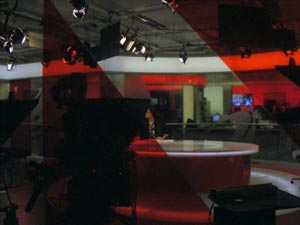 Coventry University’s Teo Beleaga gives us a student’s eye view of the BBC’s multimedia newsroom.
Coventry University’s Teo Beleaga gives us a student’s eye view of the BBC’s multimedia newsroom.
The BBC opened its gates on Tuesday night for students and members of the Media Society to come and observe its newsroom at work.
Although centralized into one enormous room and called a multimedia newsdesk, the new BBC newsroom (opened last spring) is still separated into television, online and radio departments. In one corner, less than 10 people are in charge of everything that comes from wire agencies and are the only team dealing with all the platforms at once.
It’s still too early to mix all the platforms into one multimedia department, but as Radio 4 presenter Peter Day, our tour guide, said: “We have a morning meeting where everyone learns what everyone does. We try to deliver the same content.”
The six o’clock news bulletin is ready at least a half-an-hour before broadcast, when the director, Chris Cook, starts the rehearsal of the running order and the studio camera captions. Fifteen minutes after, the presenter puts his newsface on and they start rehearsing the headlines.
They may get it wrong in practice, but when its live, the bulletin unfolds naturally. When watching, an untrained eye couldn’t tell just how much hard work goes on behind the scenes.
Our tour was followed by a debate on the future of news, chaired by Nick Pollard and featuring Mary Hockaday, head of the BBC’s multimedia newsroom; Stephen Cole, Al-Jazeera presenter; Jonathan Levy from Sky News; and Jonathan Munro, head of news at ITN.
“There will be new types of delivering journalism in the future. But in the end it’s about adapting the fundamental to the platforms and not creating the platforms as a fundamental change. The fundamentals are what gets you into journalism in the first place,” said Hockaday.
Commenting on the development of online journalism, journalists need to go back to basics, the panel suggested. Journalists are too polite, said Cole; while Munro said there needs to be a greater distinction between journalism and information.
“What you get on social networks may be information, but that’s not journalism,” he said, adding that the key questions like why and how are still asked by journalists.
The same journalistic checks must be applied to user-generated content and so-called ‘citizen journalism’, the panel said.
According to Levy, ‘99.9 per cent of citizen journalists are not journalists at all’: “They are people who happen to be there and have a mobile phone with them, which takes pictures. They are not citizen journalists they are video witnesses. They’ve got evidence of what’s happening in front of them.”
Teo Beleaga is a journalism and media student at Coventry University, whose students run the CUToday website.